Raising Water Consciousness through
World’s Biggest Photo Exhibition and
Largest collection of Photo Stories on Water
Photo Stories | Drinking Water A story based on the theme of World Water Day 2019
Impediments to Enjoyment of the Human Right to Water: An Insight on the 'Quality' Norm
Nandita Singh and Om Prakash Singh
28 December, 2019
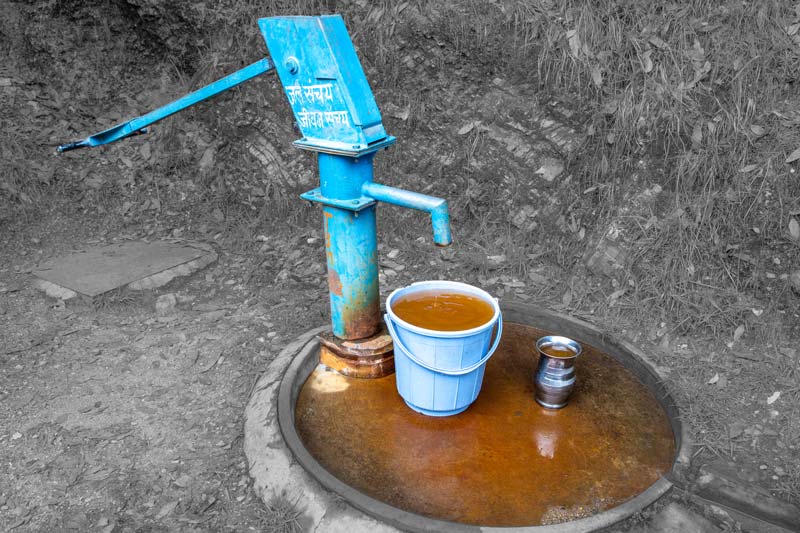
The human right to water is an inalienable component for progressing towards the UN Sustainable Development Goals (SDGs) by 2030. This right entitles everyone, without discrimination, to sufficient, safe, acceptable, physically accessible and affordable water for personal and domestic use. The UN framework on the right lays down a number of basic norms related to water, namely, availability, quality, physical accessibility, affordability, non-discrimination and information accessibility, and as elaborated in a previous story dated 16 April 2019, several norms and goals have already been set up in India in this context. However, a series of photo stories published between May and October 2019 illustrate that one or more of the above-stated norms remain unfulfilled in rural and urban India, thwarting realization of the right. The previous story dated 30 November 2019 explored the impediments to fulfilment of the water 'availability' norm. This photo story takes a look at the second norm, namely, water 'quality', which lays down that the water required for each personal or domestic use must be safe, therefore free from micro-organisms, chemical substances and radiological hazards that constitute a threat to a person's health. Further, water should be of an acceptable color, odor and taste for each personal or domestic use. This norm is extremely significant for India where both surface and groundwater resources are becoming increasingly degraded due to contamination from multiple sources. Water quality monitoring of major rivers undertaken by the Central Pollution Control Board (CPCB) indicates that organic pollution is predominant and almost all surface water sources are contaminated by coliform bacteria. Similarly, many stretches of these waters are chemically contaminated from untreated industrial effluents. A CPCB report from 2018 identified 351 polluted stretches on 323 rivers, many of which are tapped for drinking water supply. Similarly, groundwater is the source for about 85% of rural drinking water schemes in the country, but according to a 2018 report from Central Ground Water Board (CGWB), in a large part of the country groundwater is contaminated with high concentrations of fluoride, iron, arsenic, nitrate, salinity, different kinds of agrochemicals, hazardous heavy metals like lead, cadmium and chromium, and others. In this light, it is essential to ensure that the human right to water norm regarding 'water quality' is closely adhered, so that rural and urban communities can be protected from exposure to harmful contaminants through drinking water. However, as will be discussed in this story, this norm remains unattained due to several impediments that include absence of regular water quality monitoring; lack of operation and maintenance (O&M) of drinking water supply schemes; use of unprotected and/or contaminated drinking water sources; absence of adequate safe drinking water sources in quality affected habitations; lack of information, education and communication (IEC) regarding drinking water quality; and wastage of valuable treated potable water. The title photo depicts a handpump supplying drinking water that contains high level of iron in a hilly rural habitation in Nainital district, Uttarakhand. According to the local residents, this water cannot be put to any personal or domestic use.
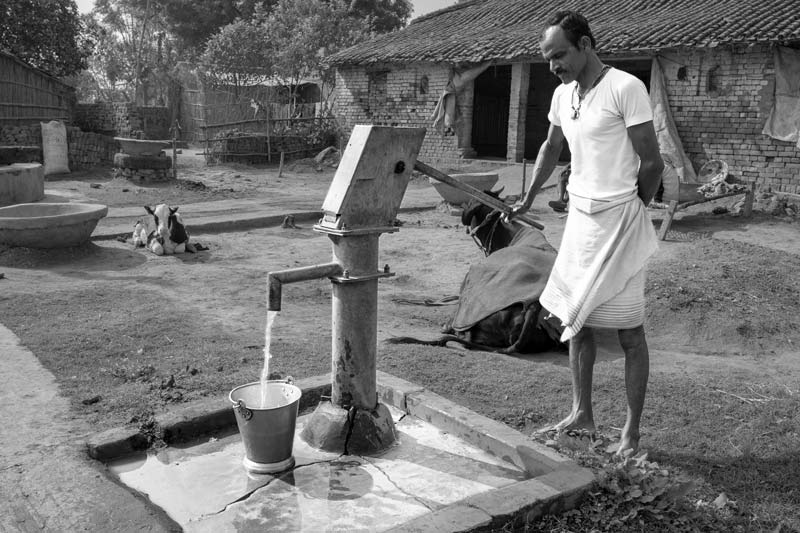
Risk of exposure to arsenic due to lack of water quality surveillance in an arsenic-affected area in Bhojpur district, Bihar
For following the human right to water norm on water quality, the first and foremost requirement is testing the quality of all waters supplied for personal and domestic use and regular monitoring of the same. Drinking water quality norms in India have been set-up by the Bureau of Indian Standards (BIS), which have been adopted under the National Rural Drinking Water Programme (NRDWP). For urban areas, the Central Public Health and Environmental Engineering Organisation (CPHEEO) has defined water quality standards, 100% adherence to which is required under the Service Level Benchmarks defined for urban water supply services. On the whole, there exists much emphasis on surveillance and monitoring of water quality in the country. However, as noted in a Performance Audit of the NRDWP conducted by the Comptroller and Auditor General (CAG) of India (2018), there exist extensive shortfalls, with prescribed water quality testing for bacteriological and chemical contamination rarely conducted. Underlying causes include non-functioning of labs and equipment, manpower shortage and lack of funds. The photo above depicts the situation in one of the arsenic-affected areas of Bihar - Barhara Block in Bhojpur district - where lack of surveillance and monitoring of the local groundwater-based drinking water sources leaves people exposed to the risk of consuming arsenic-contaminated water.
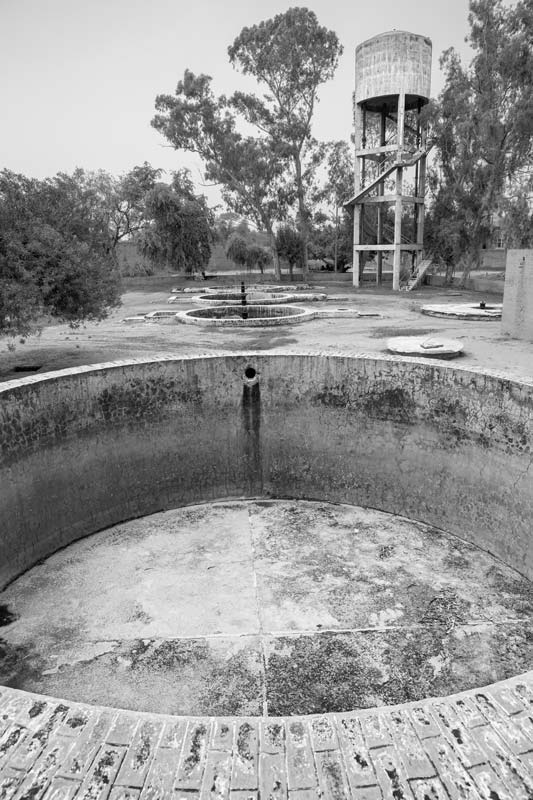
A non-operational waterworks installed for supplying potable water in a quality-affected habitation in Bathinda district, Punjab
In order to reach the drinking water quality norms set by BIS or CPHEEO, the water obtained from surface water sources such as rivers, lakes or canals must be purified before supplying to rural and urban habitations. However, a good number of drinking water treatment facilities remain non-functional due to lack of O&M. The waterworks shown in the above photo was set up in a village in the mid-1980s for biological treatment of water from an irrigation canal before supplying for drinking. However, according to the villagers, the treatment unit here has been non-functional for the last 15 years due to lack of maintenance of its filter. Meanwhile, even the groundwater in this area has come to be affected by fluoride, iron, nitrate and possibly arsenic. As a result, the only choices available before the villagers are the untreated microbially contaminated canal water (directly supplied through the piped water network) or the chemically contaminated groundwater.
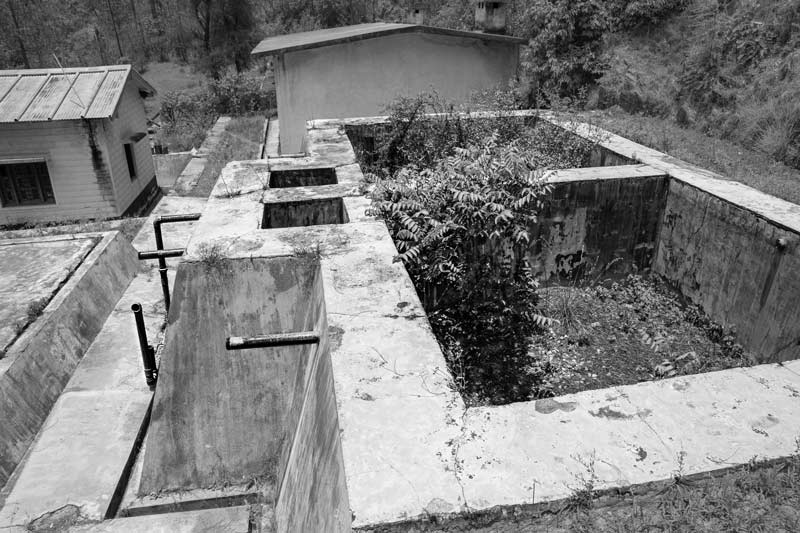
Defunct water treatment facility in Nainital district, Uttarakhand
For supplying safe drinking water in the hilly areas, several small and big water supply schemes sourced from local streams have been installed. However, the fate of these schemes is no different than those in the plains. The photo above shows the status of a rural water supply scheme in a village in the Himalayas where, according to its operator Narendra Singh Nehan, the treatment facility has never been operational since its installment in 1985. Consequently, the people are supplied with untreated stream water which, at least in recent years, is being increasingly seen as biologically contaminated, and residents report health issues on consuming the supplied water.
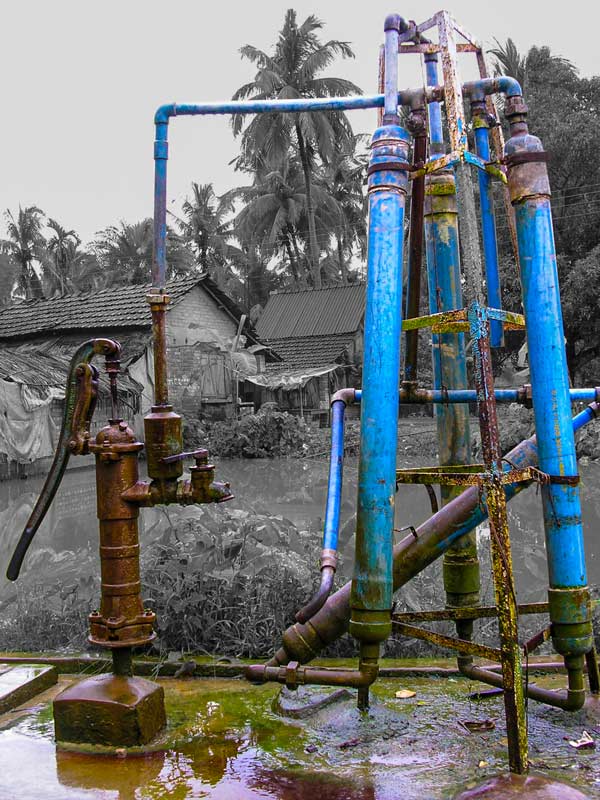
A defunct handpump-attached arsenic treatment plant in South 24 Parganas, West Bengal
In India, 90% of rural drinking water supply and 50% of urban supply is estimated to be groundwater-based. However, according to government data from December 2018, as many as 61,635 rural habitations are 'quality-affected', with groundwater-based sources containing excess of fluoride, arsenic, iron, salinity and nitrate. Several urban habitations are similarly affected. However, according to the CAG Report on NRDWP (2018), community water purification plants (CWPPs) such as reverse osmosis (RO) plants, iron removal plants, arsenic treatment units and defluoridation plants were provided in only 5.4% of affected rural habitations. Moreover, many of the units installed have ended up as non-functional due to lack of maintenance. According to recent government sources, 18,258 rural habitations in India, with a population of 17 million, are exposed to the risk of consuming arsenic through contaminated groundwater. West Bengal leads the list of arsenic-contaminated States with 9,250 rural habitations affected. Since its first identification in the early 1980s, thousands of arsenic treatment units have been installed in the State under different projects. However, as shown in the photo above, many of these have become defunct due to lack of maintenance, as a result of which people are forced to drink arsenic-poisoned water.
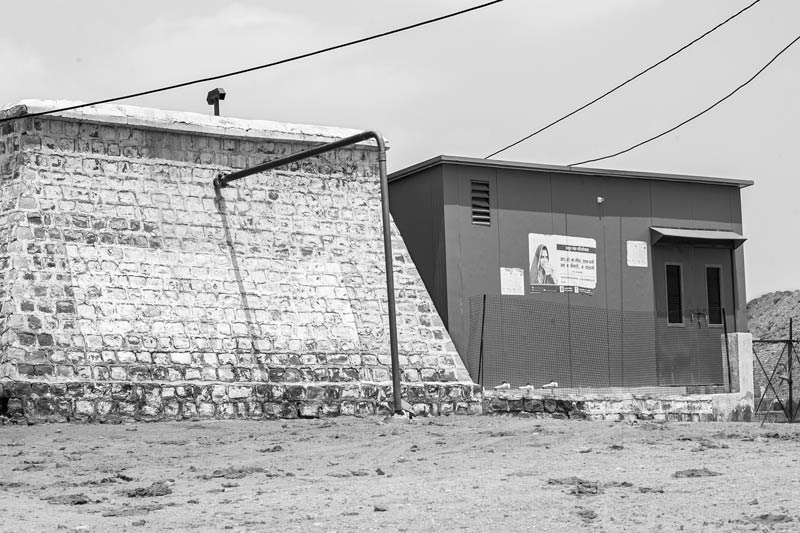
A defunct reverse osmosis (RO) plant for supplying safe water in a quality-affected habitation in Jaisalmer district, Rajasthan
In Rajasthan, with over 85% of rural water supplies dependent on groundwater, 18,478 rural habitations have been identified as 'quality-affected', as per government data from December 2018. Salinity is predominant in Rajasthan where according to CAG report on NRDWP (2018), 12,800 habitations are affected. It is also the State with maximum number of fluoride contaminated habitations, numbering 6,695 (CAG report, 2018). For mitigating these contaminants in Jaisalmer and Barmer districts, where fluoride concentration in groundwater has been found to range as high as 10-20 mg/l (1.5 mg/l being the 'permissible limit' under BIS guidelines), the CAG report notes that 57 RO plants were installed at a substantial cost of Rs. 70 million (approx. 982,000 USD). However, these plants were all non-functional due to lack of maintenance. Additionally, Rajasthan government has spent more money in installing RO plants under the 'Amrit Jal Pariyojana' in more than 500 fluoride-affected rural habitations, with treated water available at Rs. 4 for 20 Liters. Though the company responsible for installing the ROs was also required to undertake O&M for 7 years, a number of RO plants under the scheme have become non-operational due to absence of maintenance. One such non-functional RO plant is shown in the photo above.
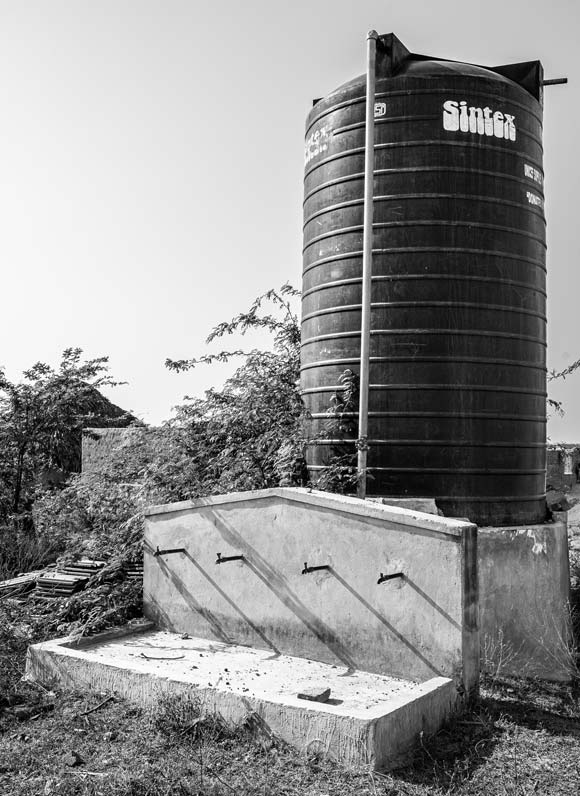
A non-executed alternate drinking water supply scheme in a salinity-affected habitation in Nellore district, Andhra Pradesh
Apart from lack of maintenance of drinking water supply schemes (including water purification units), water quality for personal and domestic use also remains compromised because many schemes remain non-executed or incomplete. The CAG report on NRDWP (2018) points out that even after expenditure of millions of rupees, procured technologies remain uninstalled or water supply schemes never reach completion. Coastal areas in Nellore district are affected by salinity in groundwater, making handpump water non-potable. For addressing the problem, alternate arrangement for supply of potable drinking water have been attempted, such as the one shown in the photo above. However, this public standpoint-based water supply scheme remained incomplete because the tank was never connected to a non-saline water source. Such is the status in many quality-affected habitations.
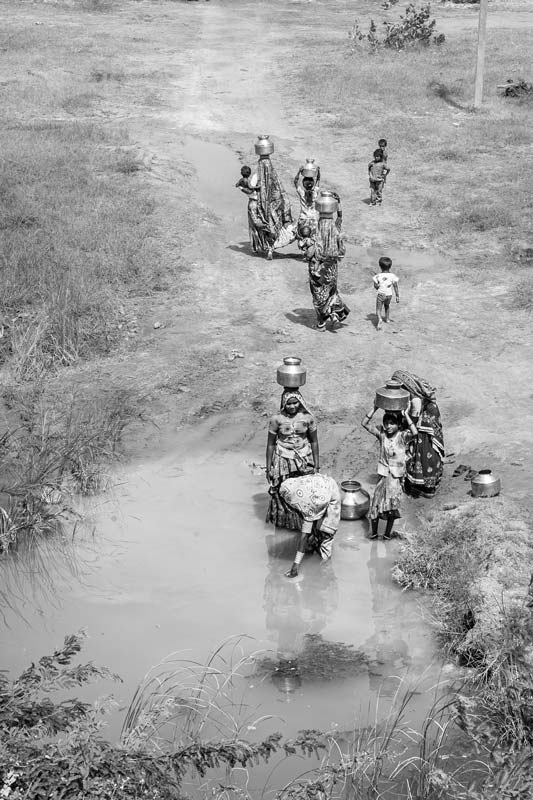
Use of an unprotected drinking water source in Kutch district, Gujarat
In many rural and urban habitations, not all segments of population can enjoy access to water for personal and domestic use which is sufficient and of acceptable color, odor and taste, due to drying up of sources, seasonal fluctuations in water supply, or absence of appropriate water quality. Such uncovered populations are forced to procure drinking water from any alternate available source, which in many cases, may be unprotected, compromising the quality of the water consumed. In Kutch district, salinity of groundwater is a significant problem which impacts people's access to water of an acceptable quality. In some places, fluoride in groundwater is also an issue, restricting people's dependence on groundwater-based drinking water sources. This forces many to depend upon alternate drinking water sources, which may have no arrangement to protect the water from contamination. One such instance is shown in the photo above.
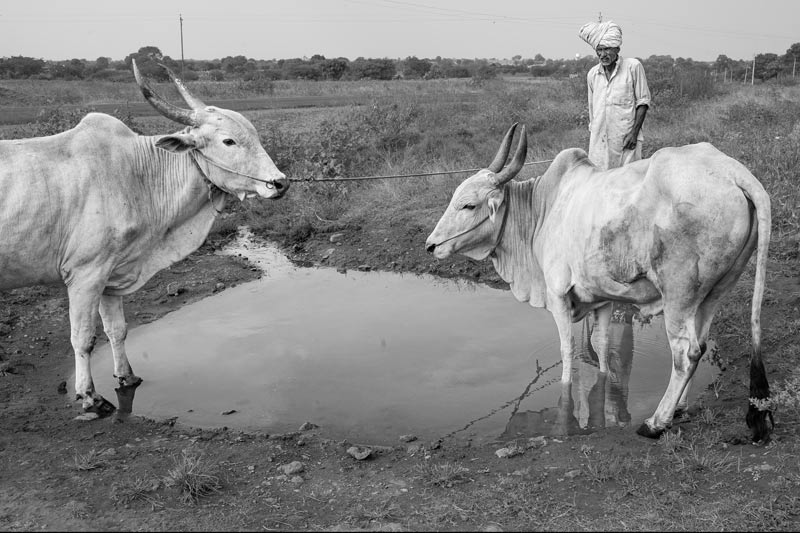
An improvised but unprotected common drinking water source for animals as well as human beings in Ahmednagar district, Maharashtra
Groundwater quality is emerging as a significant concern in Ahmednagar district of Maharashtra, salinity, nitrate and hardness being important concerns. Consequently, in a number of areas, groundwater-based drinking water sources are turning unsuitable for drinking purposes. The situation is further aggravated by subsequent droughts in the recent years in this and other neighboring districts, causing groundwater-based drinking water sources to become unyielding especially during the dry summer months. In May 2019, over 3,880 villages of the district were reported as reeling under severe water scarcity. A pertinent issue in such circumstances is to procure 'sweet' water in sufficient quantity for personal and domestic uses, especially for drinking. The photo above shows an alternative used by residents of a hamlet which has groundwater-based sources plagued by salinity and seasonal scarcity. However, there do not exist any alternate drinking water sources to address these challenges. Hence, the residents use an improvised source which is a water pool resulting from leakage from a pipeline passing underneath. This pipeline carries raw water from a nearby dam. As evident, this is an open unprotected source located near a highway which is used for multiple purposes including watering of animals as shown in the photo, and also for drawing drinking water.
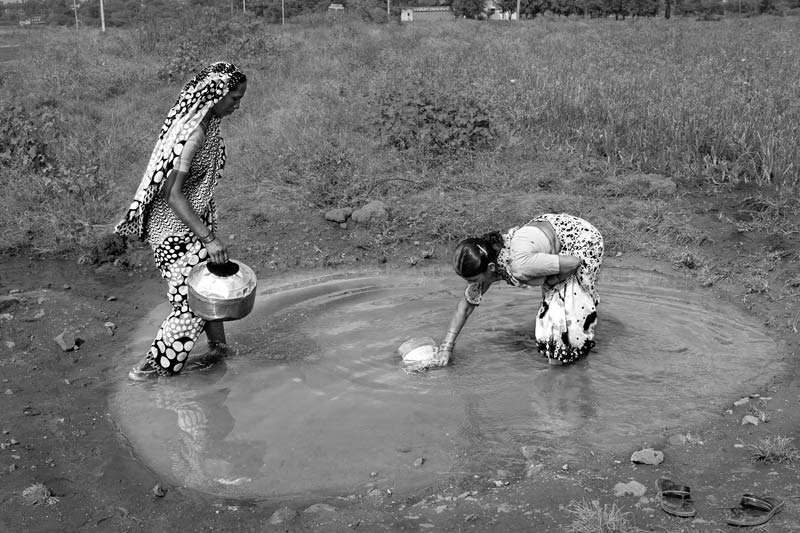
Procuring drinking water from the same unprotected water source shown earlier in Ahmednagar district, Maharashtra
In the absence of a potable water source in the hamlet, women procure drinking water from same pool which is formed by water leakage from a pipeline and used by bullocks as shown in the previous photo. There exists little doubt that water in the pool is physically dirty, biologically contaminated and possibly chemically affected, making it unfit for human consumption.
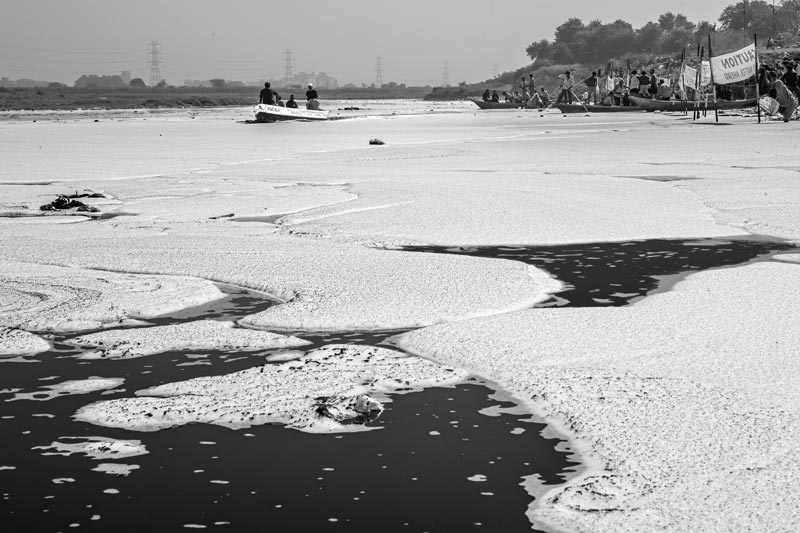
A highly polluted stretch of Yamuna river – the source of drinking water for many cities and towns - in South-East district, National Capital Territory of Delhi
Surface water resources in India – primarily rivers and lakes – have become highly polluted due to release of raw municipal sewage, untreated industrial effluents, and agricultural runoff. Drinking water supply schemes based on these water bodies ordinarily supply water after purification through communal treatment processes. However, since these processes are designed to remove only microbiological contamination and physical constituents like suspended solids (turbidity) at moderate concentrations, heavily polluted surface waters are generally unable to reach the BIS or CPHEEO standards even after purification. A classic example in this context is river Yamuna shown the photo above. The stretch of this river in the National Capital Territory of Delhi (NCTD) is less than 2% of its total length, but over 90% of its pollution load is estimated to be received here from huge amounts of untreated sewage and industrial effluents coming from 18 drains. The extent of pollution is so high that the river has been declared 'dead' with virtually no dissolved oxygen after exiting the city. This has severe implications for drinking water supply sourced from the river in downstream cities and towns like Agra, Mathura and Vrindavan. Further, Yamuna meets Ganga at Prayag, and thereafter, Ganga carries Yamuna's pollution load downstream, flowing through the most densely populated area of the country, where many cities and villages draw their drinking water through water supply schemes based in the river.
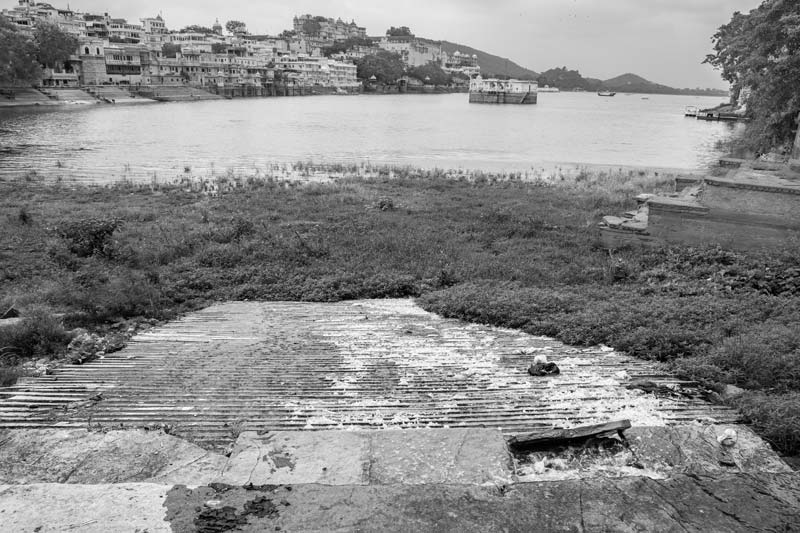
Sewage discharged from an open drain in Lake Pichola - a drinking water source in Udaipur, Rajasthan
The fate of lakes, tanks and reservoirs used for drinking water supply in urban and rural India is no different from that of rivers. Discharge of untreated domestic sewage, agricultural runoff and industrial effluents are a common problem. In the dry State of Rajasthan, where the average annual rainfall is barely 531 mm, rainwater has been the most important source of drinking water, with several small and big lakes and reservoirs harvesting the scanty rains. Udaipur – the City of Lakes – is so named because of its historical dependence upon a chain of interconnected lakes in and around the city. Of these, Lake Pichola and Fateh Sagar have been the main sources of city's municipal water supply for decades. However, the quality of water in these lakes (and others in the system) has been steadily declining. According to recent studies, the organic load in the lakes is high, while dissolved oxygen (DO) is low, primarily due to dumping of a large part of the city's untreated sewage. The photo above shows an open drain discharging untreated sewage into Lake Pichola. According to a study published in 2018, a significant part of the population studied complained that color of the municipal water supplied is yellowish, especially in rainy season. Further, about 30% of them reported dependence upon water purifiers at home, since gastro-intestinal ailments are commonplace, for which the municipal water supply is primarily blamed.
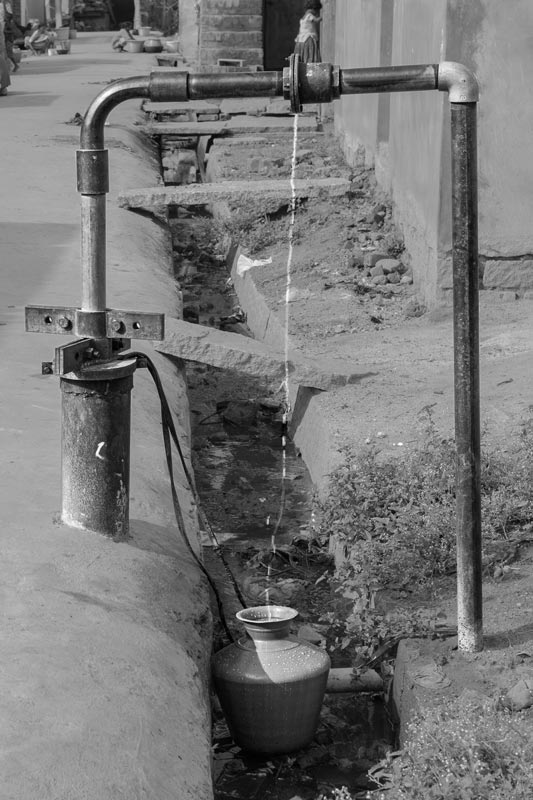
A public tubewell producing drinking water containing high fluoride and salinity in Kolar district, Karnataka
Drinking water supply from contaminated sources is also true for groundwater-based supplies. According to the CAG report on NRDWP (2018), in a good number of cases audited, new groundwater-based piped water supplies installed during the period 2012-17 turned out to be producing contaminated drinking water having high fluoride, iron, or heavy metals such as arsenic, manganese, aluminium, uranium, lead, cadmium and selenium. In many other cases, older ostensibly 'safe' groundwater sources have turned contaminated over a period of time. Karnataka is the fourth worst fluoride-affected State in the country, where several habitations report multiple contamination with salinity, nitrate and other contaminants. According to CGWB (2012), in many parts of Kolar district, groundwater quality is affected by fluoride, salinity and nitrate, but rural drinking water supplies continue to be highly dependent on groundwater, irrespective of their quality. The tubewell shown in the photo above was installed for a piped water supply scheme without any prior surveillance of the water quality, but afterwards the supplied water turned out to be saline as well as fluoride-contaminated.
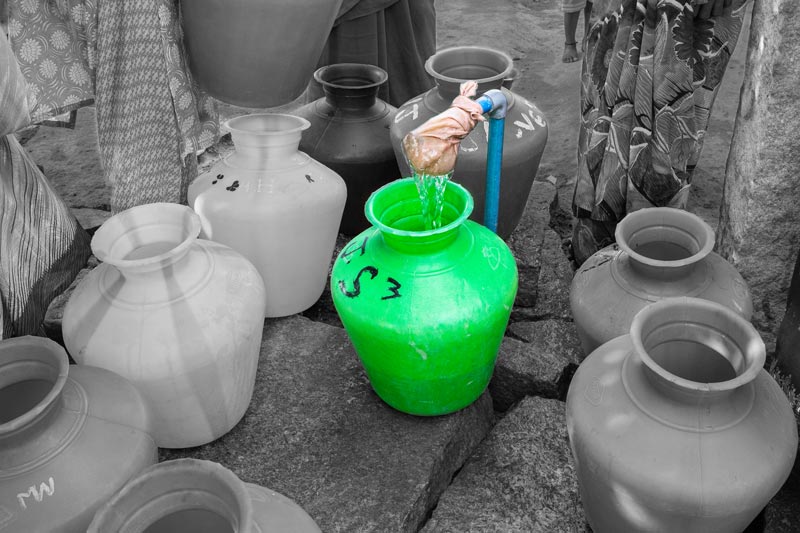
Procuring fluoride-contaminated and saline drinking water at a public standpoint supplied by the tubewell shown earlier in Kolar district, Karnataka
Despite the water quality status of the tubewell shown before, it continues to supply water for personal and domestic use through a piped water supply scheme as seen in the photo above. The public standpoint where women are filling their containers, has no water purification plant installed, forcing the local public to drink saline water containing high concentration of fluoride.
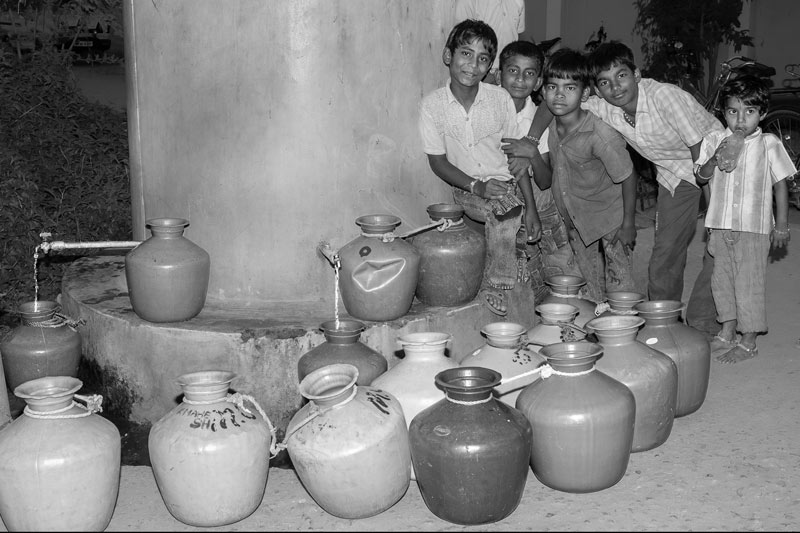
Little potable water but many seekers in a colony in Anantapur town, Andhra Pradesh
In the quality affected areas, there may be a huge difference between demand and supply of potable water. This may be a result of ignorance of authorities about water quality problems, absence of CWPPs in quality-affected habitations or lack of operation of safe water sources due to failure of O&M, or even incomplete works. This often goes hand-in-hand with an underestimation of the dependent populations when drinking water supplies are installed. Consequently, in many quality-affected habitations, larger than identified numbers end up queuing up for the ostensibly 'safe' water. Given the limited supply in terms of quantity and time, many may however remain unserved at the end. In Anantapur district, groundwater is affected by salinity, fluoride and nitrate, with fluoride concentration as high as 45 mg/l and nitrate upto 600 mg/l, against permissible limits of 1.5 mg/l and 45 mg/l respectively (CGWB, 2013). However, provision of safe drinking water alternatives in the affected habitations has been inadequate, making people queue up at neighboring water supply points, an instance of which is depicted in the photo above.
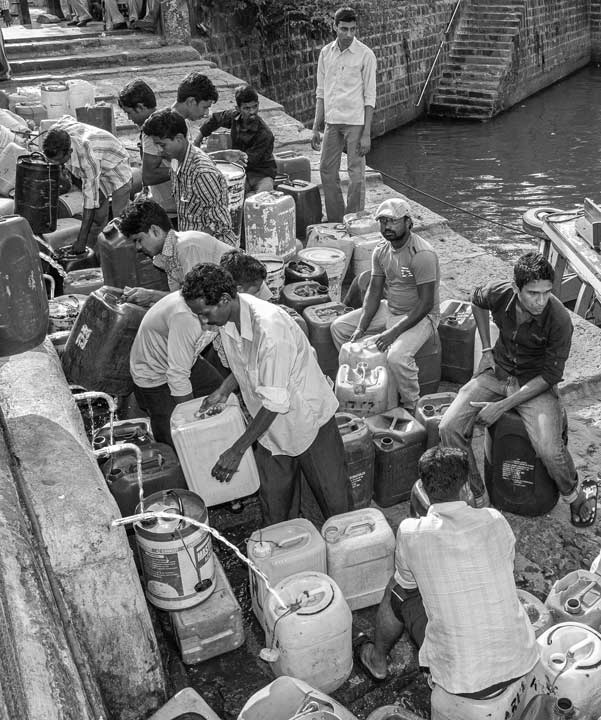
Rush of boatmen for collecting potable water at a public standpoint on the waterfront at Mumbai Harbor, Maharashtra
Coastal areas are especially prone to drinking water quality challenges due to salinity of the sea water. Near the seashore at Gateway of India in Mumbai, those owning and working on boats face challenge in procuring drinking water for themselves and their passengers. Though they have water all around, sweet water needs to be procured from land, where sources for them are limited. Everyday more than 100 boatmen crowd at the public standpoint at Gateway of India with over 1000 containers, waiting to be filled within a supply time of barely 1.5 hours. This huge difference between demand and supply makes drinking water procurement a struggle for the boatmen, forcing them to wait in long queues or sometimes even getting into conflicts.
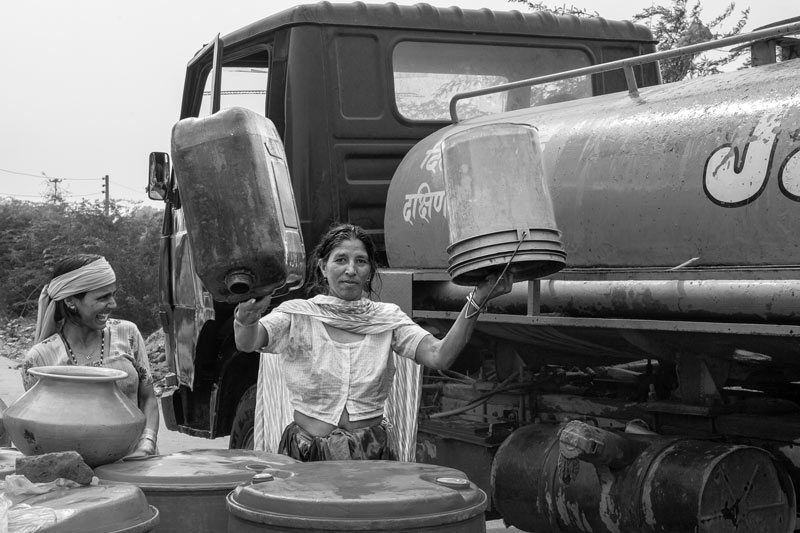
Potable water supplied through tanker proving too little to fulfil everyone's need in a salinity-affected village in South-West district, National Capital Territory of Delhi
In many villages in this part of NCTD, handpumps and tubewells have been the common sources of water supply for personal and domestic use. However, groundwater quality in the capital of India has been progressively deteriorating, with salinity, fluoride, nitrate and even arsenic reported. In order to provide safe drinking water in the quality-affected rural habitations, local authorities provide tanker water supply. However, this supply is very limited in terms of the quantity, given the large number of seekers. Moreover, it is generally scheduled only once a week per habitation. This leaves many people unserved, as shown in the photo above.
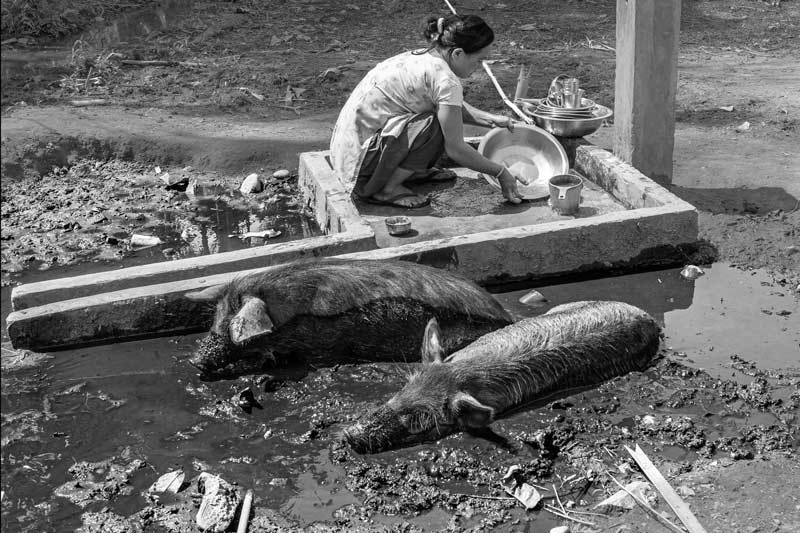
Insensitivity towards safe upkeep of drinking water sources in East Siang district, Arunachal Pradesh
Inability to attain the human right to water norm of water quality is also sometimes a result of lack of adequate and effective information, education and communication (IEC). The problem of water quality can be solved by reverting to safe sources or by consuming appropriately treated water. Further, in many cases, drinking water becomes unsafe because of inappropriate handling of the water source or the water resource itself. In all such cases, the users need to be informed, educated and sensitized about best practices. However, as evident in the above photo, and revealed by the local community, there has never been any specific local IEC activity about the need and ways to maintain water hygiene at community and household levels. IEC with regard to drinking water quality may require behavioral change communication (BCC), since dimensions like 'hygienic' practices at drinking water sources and adoption of safe drinking water sources (in quality-affected areas) are often culturally rooted, requiring culture-specific solutions. But unfortunately, IEC campaigns in water sector tend to follow universal 'one-for-all-fit' approach, denying the users an opportunity to reconsider and amend their water quality-related beliefs and practices.
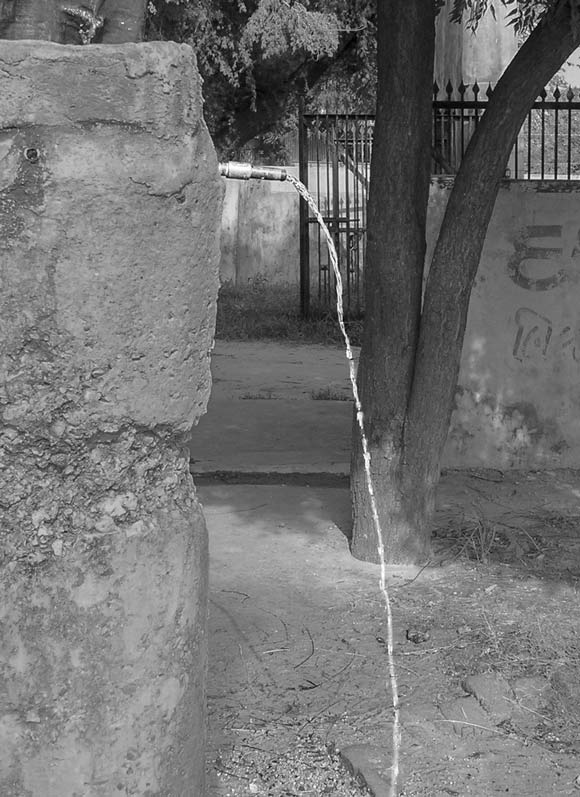
Wastage of precious treated water in an area affected by fluoride and salinity in Patan district, Gujarat
Another important factor thwarting attainment of the water quality norm is wastage of precious treated water. At many places, safe water has been made available to urban and rural communities through treated piped water supplies. Built for universal access to this treated water, the piped water network needs to be carefully managed, with zero leakage and 'use-according-to-need' principle. However, networks are often ill-maintained and suffer from large-scale wastage of the precious treated water, the major culprits being unrepaired leakages and missing taps – that were either not installed from the start or never replaced once broken. The photo above shows colossal wastage of treated water at a public standpoint that was never fitted with a tap in Patan district - an area severely affected by salinity and fluoride. According to CGWB (2014), of a total of 517, 126 villages here are affected by fluoride and 110 by salinity. Water wastage from piped networks thwarts habitations located downstream from accessing safe water.
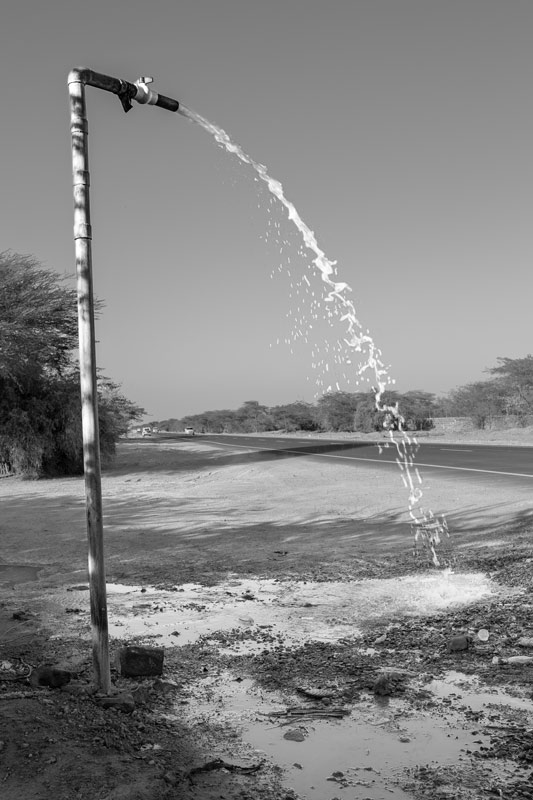
Unchecked wastage of precious potable water from the Indira Gandhi Canal supply in water-scarce, salinity and fluoride-affected Thar Desert in Jaisalmer district, Rajasthan
For fulfilling water needs in the parched Thar Desert of Rajasthan, where groundwater in many pockets is affected by salinity and fluoride, while surface water sources are conspicuous by their near absence, the Indira Gandhi Canal (IGC) was constructed to ensure availability of high-quality river water in adequate quantities from Ravi, Beas and Sutlej in Punjab. The IGC water is made potable and supplied to several cities, towns and villages in the desert. However, there is continuous mismanagement of this precious water, an instance of which is shown in the photo above. At this IGC-fed water point, water tanker drivers almost never close the tap after filling their containers. Consequently, gallons of the precious resource keep getting wasted, thwarting availability of safe and adequate water further downstream. And this wastage becomes a greater concern during summer months when water level in the canal gets depleted. Unfortunately, this irresponsible act of water wastage has remained unnoticed by the authorities responsible for upkeep and maintenance of IGC and the water supply.
This photo story has enumerated the impediments to fulfilment of the water 'quality' norm that constitutes the second and an extremely vital requirement for enabling enjoyment of the human right to water, as outlined in the General Comment (GC) No. 15 of the UN Committee on Economic, Social and Cultural Rights (2002). The impediments to fulfilling the norm are, first, the lapse on part of authorities to regularly undertake surveillance and monitoring of water quality at all drinking water delivery points in rural and urban habitations. As a result, the problem of water quality remains unidentified, and people continue drinking contaminated water in ignorance. Second, while all rural and urban water supply schemes are supposed to adhere to the drinking water quality norms set out by BIS or CPHEEO, lack of their O&M is widespread, forcing people to revert to the contaminated sources earlier in use. Third, in a good number of quality-affected habitations and otherwise, schemes for safe water supply are initiated but never completed. Fourth, at some places unprotected drinking water sources are in use in the absence of safe sources. Fifth, at many places, drinking water is supplied from polluted sources, the water from which cannot be purified to the expected standards with the existing conventional technologies, or the fact of contamination is just ignored. Sixth, there exists huge difference between demand and supply of potable water, especially in quality affected habitations, depriving many of the opportunity to procure safe water. Seventh, lack of appropriate and adequate information, education and communication (IEC) in this regard prevents people from using the right source or handling/maintaining drinking water in the right way. Finally, large-scale wastage of valuable treated water deprives the access of needy to safe drinking water. As a result of these impediments, women, men and children in many rural and urban habitations of India continue to consume qualitatively degraded water. Evidence of continued exposure to contaminated water comes from the high figures for death resulting from diseases like diarrhea, which according to UNICEF was 102,813 children under five (about 10%) in 2016. Another indicator is the prevalence of fluorosis for which the number of patients in India is estimated by a study in 2015 as 62 million, including 6 million children below the age of 14 years, with contaminated groundwater as the major cause. Similarly, according to recent government estimates, about 239 million people are exposed to risk of arsenicosis through exposure from contaminated groundwater. Declining health has several spin-offs at household level. It impacts men and women's physical capabilities at work, thereby thwarting livelihoods and economic well-being. It can also restrict children's education and development, and ultimately, the death of a bread-winner can doom families into unending traps of insecurity and poverty. Water quality as a human right to water norm is thus an important precondition for reaching the SDGs, being vital for SDG 6 – leaving no one behind in access to clean water and sanitation – and also others such as 3 (good health and well-being), 4 (quality education), 5 (gender equality), 10 (reduced inequalities), and 11 (sustainable cities and communities). Given the quality status of India's surface and groundwater resources, it is quintessential that effective steps be undertaken to ensure attainment of the human right to water norm on water quality. This would be all the more vital in an era when climate change and other forms of global transformation such as urbanization and industrialization put increasing stress on water quality.